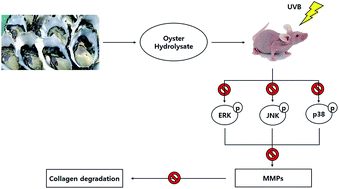Oral administration of oyster (Crassostrea gigas) hydrolysates protects against wrinkle formation by regulating the MAPK pathway in UVB-irradiated hairless mice
Abstract
Chronic ultraviolet (UV) irradiation induces wrinkle formation. UV exposure increases reactive oxygen species (ROS) and upregulates the expression of matrix metalloproteinases (MMPs), which results in skin photoaging. Oyster (Crassostrea gigas), which is an abundant food resource in Asia and Europe, contains various sources of biological compounds and has several effects. Also, oyster hydrolysate (OH) has many biological activities. We investigated the inhibitory effects of OH on wrinkle formation in UVB-irradiated hairless mice. We induced UVB irradiation in hairless mice for 18 weeks and administered OH orally from the 9th week to the 18th week. We performed skin replicas and histological analyses in UVB-irradiated hairless mice dorsal skins. To determine the inhibitory mechanism of OH on wrinkle formation, we measured gene and protein expressions in dorsal skin using RT-qPCR and western blot analyses respectively. In our study, OH decreases wrinkle formation, epidermal thickness and collagen degradation in UVB-irradiated hairless mice. The gene expressions of MMPs were decreased and the gene expressions of collagen type I and TIMP-1 were increased in OH administered groups. Like gene expression tendencies, the protein expressions of MMPs were reduced and that of collagen type I was increased. Furthermore, the phosphorylation levels of ERK, JNK, and p38 were reduced in OH administered groups. We found that OH inhibits wrinkle formation, skin thickening, and collagen degradation by downregulating the MMP expression via the regulation of phosphorylation of MAPK. The results showed that OH significantly prevents UVB-induced photoaging in dorsal skin. Consistent with in vivo data, OH has potential as an anti-wrinkle agent.



 Please wait while we load your content...
Please wait while we load your content...